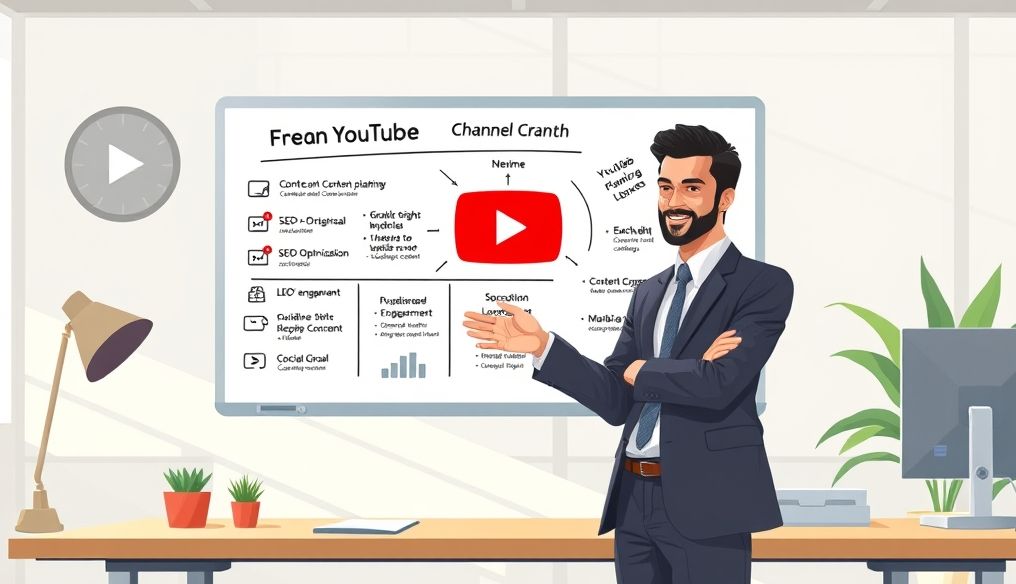Introduction: YouTube and Opportunities in the Arab World
YouTube is not just a platform for watching videos, but an ocean of immense economic opportunities, especially in the Middle East and North Africa region. With the increasing number of internet users and the rising rate of video viewership, YouTube has become an ideal platform for building a personal brand and generating profit.
In this article, we will explore in detail how you, as a beginner, can build a successful personal brand on YouTube in the Arab world, and turn your passion into a sustainable source of income.
Chapter 1: Defining Your Goal and Passion
1.1 Discovering Your True Passion
The first step towards building a successful personal brand is identifying your true passion. What topics do you enjoy talking about? What skills do you possess that you want to share with others?
Find the intersection between your passion and the interests of your target audience. This will ensure you enjoy creating content, and therefore, continue doing it in the long run.
1.2 Identifying Your Target Audience
Who are the people you want to reach? What are their interests and needs? What problems are they facing that you can help them solve?
The deeper your understanding of your target audience, the more engaging and relevant content you can create for them.
1.3 Defining Your Channel's Goal
What is the goal you are trying to achieve through your YouTube channel? Do you want to build a community? Do you want to sell products or services? Do you want to get sponsorships from companies?
Defining a clear goal will help you focus your efforts and measure your success.
Chapter 2: Keyword Research and Trending Topics
2.1 Using Keyword Research Tools
Keyword research tools like Google Keyword Planner, Ahrefs, and Semrush help you find the keywords your target audience is searching for.
Look for keywords related to your area of interest that have a high search volume and low competition.
2.2 Analyzing Competitors
Analyze competing YouTube channels in your area of interest. What topics are they covering? What keywords are they using? What types of content are they providing?
Don't blindly copy competitors, but be inspired by them and try to provide unique and distinctive content.
2.3 Following Trending Topics
Follow trending topics on YouTube and other social media platforms. What topics are people talking about? What challenges are they participating in?
Try to incorporate these trends into your content in a creative and innovative way.
Chapter 3: Creating a Professional YouTube Channel
3.1 Choosing a Catchy Channel Name
Choose a catchy and memorable channel name that reflects the content of the channel.
Make sure the channel name is available on YouTube and other social media platforms.
3.2 Designing a Channel Logo and Cover Image
Design an attractive and professional logo that reflects your brand identity.
Design an attractive cover image that showcases the content of the channel and expresses your personality.
3.3 Writing a Compelling Channel Description
Write a concise and compelling description of your channel that explains the content of the channel and the benefits of subscribing to it.
Use keywords related to your area of interest in the channel description.
Chapter 4: Producing High-Quality Content
4.1 Content Planning
Plan the content you will be providing on your channel in advance. Create a content calendar that specifies the topics you will be covering in each video.
Make sure the content you provide is valuable and useful to your target audience.
4.2 Video Recording
Use a high-quality camera and microphone to record the video.
Pay attention to the lighting and sound in the video.
Practice speaking in front of the camera before recording.
4.3 Video Editing
Use video editing software to edit the video and add visual and audio effects.
Make the video short, entertaining, and easy to watch.
Chapter 5: YouTube Search Engine Optimization (SEO)
5.1 Writing Catchy Titles
Write catchy and interesting titles that attract viewers to click on the video.
Use relevant keywords in the title.
5.2 Writing Detailed Descriptions
Write detailed descriptions of the video that explain the content of the video and its benefits.
Use relevant keywords in the description.
5.3 Using Tags
Use tags related to the video content to help viewers find the video.
5.4 Creating Attractive Thumbnails
Design attractive and interesting thumbnails that attract viewers to click on the video.
Chapter 6: Promoting Your YouTube Channel
6.1 Promotion on Social Media
Share your videos on other social media platforms such as Facebook, Twitter, and Instagram.
Interact with your audience on social media.
6.2 Collaboration with Other YouTube Channels
Collaborate with other YouTube channels in your area of interest to exchange audiences.
6.3 Using YouTube Ads
Use YouTube ads to reach a wider audience.
6.4 Participating in Relevant Forums and Groups
Participate in forums and groups related to your area of interest and share your videos with members.
Chapter 7: Building a Community Around Your Channel
7.1 Interacting with Viewers
Respond to viewers' comments and questions.
Ask viewers to subscribe to the channel and turn on the bell.
7.2 Creating Polls
Create polls to find out viewers' opinions about the content of the channel.
7.3 Organizing Contests and Giveaways
Organize contests and giveaways to encourage viewers to interact with the channel.
7.4 Creating a Facebook Group or Similar
Create a group on Facebook or other social media platforms to gather viewers and interact with them.
Chapter 8: Monetizing Your YouTube Channel
8.1 YouTube Partner Program
Join the YouTube Partner Program to monetize the ads that appear on your videos.
8.2 Affiliate Marketing
Promote other products or services in exchange for a commission on each sale made through your referral link.
8.3 Selling Your Own Products or Services
Sell your own products or services through your YouTube channel.
8.4 Getting Sponsorships from Companies
Get sponsorships from companies in exchange for promoting their products or services in your videos.
8.5 Donations
Ask viewers to donate to support your channel.
Chapter 9: Performance Analysis and Continuous Improvement
9.1 Using YouTube Analytics
Use YouTube Analytics to monitor the performance of your channel and videos.
Learn about traffic sources, audience retention rate, and audience demographics.
9.2 Making Necessary Adjustments
Make necessary adjustments to your content and strategy based on the data you get from YouTube Analytics.
9.3 Keeping Up with Changes in YouTube Algorithms
Keep up with changes in YouTube algorithms to ensure your channel stays at the top of search results.
Chapter 10: Additional Tips for Success on YouTube
10.1 Be Patient and Persistent
Success on YouTube takes time and effort. Be patient and persistent and don't give up if you don't see immediate results.
10.2 Be Authentic and Transparent
Be authentic and transparent with your audience. Don't try to be someone else.
10.3 Enjoy What You Do
Enjoy what you do. If you enjoy creating content, your audience will feel it and be more likely to subscribe to your channel.
10.4 Learn Constantly
Learn constantly about YouTube and content creation. There is always something new to learn.
10.5 Connect with Other Content Creators
Connect with other content creators in your area of interest. You can exchange ideas, tips, and support.




